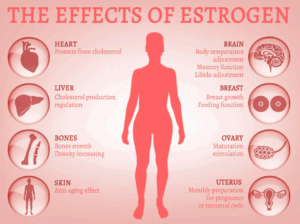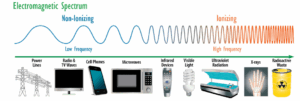We live in a world wired for convenience. Our homes hum with Wi-Fi routers, our pockets buzz with smartphones, and our cities glow with wireless signals bouncing from tower to tower. But beneath the surface of our hyper-connected lives, a quieter question is emerging: could the very tech that powers our world be disrupting the delicate balance of our bodies, especially our hormones?
A 2006 study led by Clark et al., titled “Residential Radiofrequency Exposure and Estrogen Production Among Pre- And Postmenopausal Women,” takes a surprising look at how electromagnetic field (EMF) exposure may influence two key hormones – melatonin and estrogen – especially in postmenopausal women. While the research doesn’t ring the final alarm bell, it’s a nudge in a direction many are still hesitant to look: EMFs as an invisible endocrine disruptor.
The Hormonal Symphony: Estrogen and Melatonin
Hormones are your body’s communication system – chemical messengers that control everything from sleep to metabolism to mood. Two of the most important in the conversation around environmental exposures are estrogen and melatonin.
control everything from sleep to metabolism to mood. Two of the most important in the conversation around environmental exposures are estrogen and melatonin.
Estrogen isn’t just the “female hormone.” It regulates bone density, cardiovascular health, brain function, and even the microbiome. In premenopausal women, estrogen fluctuates cyclically. Postmenopause, however, estrogen production drops sharply, and its regulation becomes more vulnerable to external influences.
Melatonin, known for its role in sleep, is produced by the pineal gland in response to darkness. But it’s also a powerful antioxidant and plays a critical role in regulating estrogen. When melatonin levels are high, estrogen levels tend to stay in check. Disrupt melatonin, and you might disturb this hormonal harmony.
What Are EMFs, and Where Do They Come From?
EMFs – or electromagnetic fields – are invisible energy waves emitted by electronic devices. The two types examined in this study were:
- Radiofrequency (RF) EMFs, which come from wireless signals like cell phones, routers, and towers.
- Extremely Low Frequency (ELF) EMFs, which originate from household electrical wiring, appliances, and power lines.

We’re exposed to both types daily, often without realizing it. While EMFs at extremely high levels (like X-rays) are already known to be harmful, the health effects of chronic low-level exposure, like the kind we get from modern electronics, are still under investigation, though an increasing number of experts are sounding the alarm bells.
Inside the Study: What the Researchers Investigated
To explore whether EMF exposure could influence hormone production, the researchers conducted a cross-sectional study of 119 women (71 premenopausal and 48 postmenopausal) living in one of the most RF-saturated areas in the U.S.
Here’s what they did:
- Measured RF levels in participants’ homes.
- Tracked ELF exposure using personal monitoring devices from sunset to bedtime.
- Collected urine samples on two separate days to assess estrogen (estrone-3-glucuronide, or E1G) and melatonin (6-hydroxymelatonin sulfate, or 6-OHMS) levels.
The goal was simple but important: identify whether exposure to these common EMFs correlated with changes in hormone levels.
What They Found: A Tale of Two Groups
The results painted two very different pictures for premenopausal and postmenopausal women.
Premenopausal Women: No Significant Effect
For women who hadn’t yet gone through menopause, there was no significant correlation between EMF exposure and estrogen production. This may be due to naturally fluctuating estrogen levels and robust hormonal feedback mechanisms during reproductive years. Or perhaps these women were less sensitive to EMF-induced melatonin suppression.
Postmenopausal Women: A Concerning Pattern
Things looked different for postmenopausal women:
- Higher home RF exposure was associated with increased estrogen levels.
- Stable ELF exposure during evening hours (sunset to bedtime) also correlated with elevated estrogen.
- Living closer to RF transmitters was linked to higher estrogen production.
In women who already had low melatonin levels, these effects were even stronger. The researchers observed a statistically significant inverse relationship between melatonin and estrogen, meaning that as melatonin dropped, estrogen rose.

Why This Matters: Estrogen, Cancer, and the Environment
For postmenopausal women, excess estrogen is a known risk factor for several conditions, including:
- Breast cancer
- Uterine cancer
- Osteoporosis (through hormonal imbalance)
- Estrogen dominance, which can affect mood, weight, and metabolism\
If EMF exposure is indeed disrupting melatonin levels and, in turn, driving up estrogen, the implications are huge. We’re not just talking about minor disruptions – we’re talking about potential contributions to chronic disease.
This study doesn’t claim causation, but the associations are compelling enough to warrant deeper investigation, especially as global EMF exposure continues to rise.
What You Can Do: 7 Ways to Reduce EMF Exposure
Even without high-tech tools, there are several ways you can reduce EMF exposure, especially during the most sensitive hours of the day.
- Unplug Wi-Fi at night. Your body regenerates during sleep, and lower EMF levels can support deeper rest.
- Use airplane mode on your phone while sleeping or working.
- Avoid wireless earbuds; opt for wired alternatives when possible.
- Don’t sleep with your phone by your head. Keep it across the room or out of the bedroom.
- Use EMF-blocking canopies or curtains if you live near a tower or substation.
- Hardwire your internet connection. Ethernet cables reduce RF exposure entirely.
- Dim artificial lights at night. Blue light and artificial brightness also suppress melatonin.
Aires: A Simple Mitigation Tool
With EMFs so deeply embedded in modern life, it’s unrealistic to eliminate them completely. But it is possible to reduce their biological impact.

Aires, a science-backed EMF modulation company, offers wearable and at-home products designed to harmonize EMF fields and reduce their disruptive influence on the body. Rather than blocking EMFs (which is difficult and impractical), Aires devices focus on modulating the waveforms – essentially reshaping them in a way that makes them less biologically reactive.
While more peer-reviewed research is, of course, needed, data – including EEG and HRV testing – suggests that Aires devices could help reduce EMF-related stress, offering a practical way to support hormonal balance in the digital age.
Beyond the Buzz: Why This Study Still Matters Today
Though this study was conducted in 2006, its implications have only grown more urgent. Today’s environment includes 5G, satellite internet, and an explosion of smart devices – all of which add to our EMF load.
Moreover, few studies have looked at how EMFs affect postmenopausal women specifically. This research opens the door for further exploration into how aging, hormonal shifts, and environmental exposures collide in ways that could influence public health.
It’s also a reminder that health isn’t just about what you eat or how you move. It’s about what you’re exposed to – sometimes silently, sometimes constantly – and how that invisible stress adds up over time.
Final Thoughts
We don’t need to live in fear of EMFs. But we do need to live with awareness.
Studies like this one challenge the narrative that everyday tech is biologically neutral. They remind us that the body is sensitive, intelligent, and responsive to its environment, and that includes the invisible fields around us.
If you’re a woman in midlife, someone struggling with sleep, or simply curious about the hidden layers of wellness, it might be time to take a closer look at your EMF exposure.
Not with paranoia, but with curiosity, intention, and a willingness to question what we’ve taken for granted.








